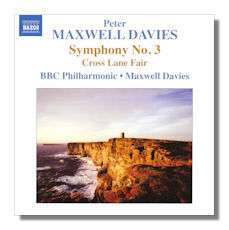
The Internet's Premier Classical Music Source
Related Links
- P.M. Davies Reviews
- Latest Reviews
- More Reviews
-
By Composer
-
Collections
DVD & Blu-ray
Books
Concert Reviews
Articles/Interviews
Software
Audio
Search Amazon
Recommended Links
Site News
 CD Review
CD Review
Peter Maxwell Davies

- Symphony #3
- Cross Lane Fair *
* Mark Jordan, Northumbrian pipes
* Rob Lea, bodhran
BBC Philharmonic Orchestra/Peter Maxwell Davies
Naxos 8.572350
Peter Maxwell Davies's music is taut, strong, sinewy, expansive, orchestrally rich, sonically striking – and usually varied in temperament and genre… from foxtrots to operas, string quartets to symphonies. Here is a very welcome rerelease on Naxos of one of the studio recordings made of Max's symphonic works by the BBC Philharmonic under the composer himself in 1993 and first made available on Collins Classics in 1994 and 1995. For such a prominent and influential composer (although probably better known in the UK than elsewhere, sadly), it is a little surprising that this is thus now the only recording currently available.
Two major influences have shaped Maxwell Davies musical career: music of the past, and the north of Scotland, where he has lived since 1971. The Third Symphony, which occupies the bulk of this generous CD (it lasts almost an hour; Cross Lane Fair 15 minutes), owes its symmetrical structure and perceptible clean drive to the proportions of Renaissance architecture. What the composer calls "long-range harmonic planning" also contributes to what in all other ways aims to be an abstract work. In fact, extra-musical entities are here: the simplicity of the Fibonacci series, an arbiter of Renaissance architectural design and implementation; the sea, and comparisons between the mathematics of shells (which obey Fibonacci, of course) and the mathematics of breakers, wave patterns, behavior and appearance. So really this long, rolling (though never erring) work is also a seascape. The playing of soloists and ensembles by the BBC Philharmonic reveals contrasts between the essentially planar nature of large oceans, and how they must be experienced by those who sail them (and live by them) as rough and with both surfaces and depths which are never still.
Oblique references to both plainchant and birdsong also add to the severe and, truly, oblique evocation in which Maxwell Davies succeeds so well over this extended period of time. Only an orchestra sympathetic to the composer's idiom can really avoid losing the motion and at the same time can allow the slow, unfolding momentum make the wonderful impression that it does (the progress through the second movement allegro is a good example). The BBC Philharmonic is just such an orchestra.
Further, they convey particularly well the almost oppressive presence of the sea: at the time he wrote the Third Symphony, Maxwell Davies was living in a small, isolated cottage at the confluence of the Atlantic and North Sea where its mood, its indifference to everything, its threat and at the same time its bounty are inescapable. These qualities as reflected in the music are amply suggested by the BBC Philharmonic. They are at pains not to curb the music's appeal by restricting what it can communicate to us. In common with most other contemporary composers, Maxwell Davies is as interested in the meta languages of music as he is with music's own connotations. Hence the relationship between tones, modes and the perspectives in which they operate is critical. Vanishing points (like those at the sea's horizon) are important. It's often those which give the music much of its forward motion. The orchestra's dynamic in the third movement is a case in point: quiet passages are never whispered; nor potentially bombastic ones overplayed. Similarly, the plangent ending after the Third Symphony's long (22 minutes) slow last movement makes quite an impact. Contrast (yet contrast determined in the same way that the sea can be thought to be – by landmasses) is kept to the fore at all points. Swell is secondary to sequence.
This of course is truly symphonic writing. And very effective it is. Maxwell Davies's is clean, accessible music, though neither conventionally tonal nor uncompromisingly atonal. Given the tradition of pastoral British music from Parry and Vaughan Williams to Britten, Maxwell Davies' is a distinct voice, if never one that breaks much new ground. His music has the feeling of successful consolidation, rather than conscious innovation about it. And, again, the BBC Philharmonic is totally at home with that.
Cross Lane Fair was composed ten years after the Third Symphony, in 1994. It's a very much lighter work: the orchestra is of chamber size with Northumbrian pipes (played by Mark Jordan) and the Irish drum, the bodhran (played by Rob Lea). The work is inspired by his memories of a fairground which Maxwell Davies visited as a child. It's not an insubstantial piece, nevertheless; and illustrates the range of the composer's imagination to anyone unfamiliar with it. Rhythms, textures, changes in atmosphere and allusions to the "street" music, surrounded by which he grew up (though on the other side of the Pennines and Irish Sea from those two solo instruments) stalk through Cross Lane Fair's nine movements, most of which last a minute or so. More than a curiosity, it makes a nice contrast with the much more thought-provoking Third Symphony.
The acoustics of the recording are as expansive and spacious as they need to be. The short liner notes that come with the CD are economical and contain only an outline background. It seems likely that Naxos will now work its way through the other symphonies of this highly important composer, thereby making them available (again) and accessible, perhaps, to new audiences. This is all to the good, given the range and depth of Maxwell Davies' musical thinking and accomplishments. No lover of contemporary symphonic music should miss the series. And these interpretations, conducted by the composer, are as persuasive as are likely to be made available. Recommended.
Copyright © 2012, Mark Sealey.





















